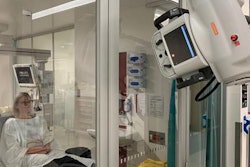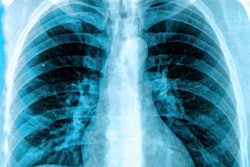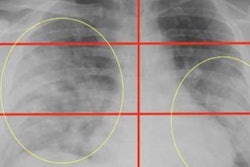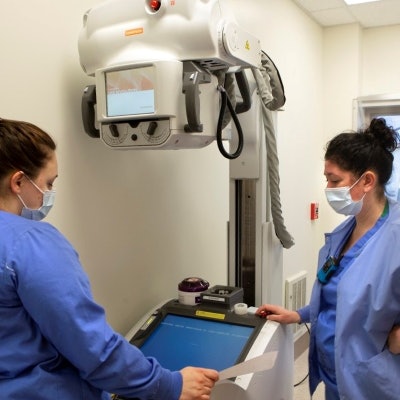
The radiology department at a Pennsylvania hospital has found some creative low-tech solutions to the problem of safely performing chest x-ray studies of patients during the COVID-19 outbreak.
Radiology facilities around the world have been grappling with the problem of meeting the need for imaging to diagnose COVID-19 patients while also preventing further spread of the SARS-CoV-2 virus. CT was touted early on as a useful tool for the job, but disinfecting CT suites after studies of every patient suspected to have COVID-19 is an arduous task.
While radiography lacks the diagnostic power of CT, it is more easily disinfected and much more portable. Mobile x-ray systems can be easily moved to a patient's bedside, obviating the need to transport potentially infectious individuals throughout a hospital.
But even with mobile x-ray, challenges remain in terms of how to safely acquire images. At Penn State Health Radiology at Milton S. Hershey Medical Center, staff and administrators recognized that the time-consuming nature of imaging patients suspected of COVID-19 could hinder their ability to also image patients with other conditions.
Their solution was to convert a storage area into a radiology annex, with an external door that's separate from the one into the main radiology department. The mobile x-ray system is positioned in the doorway, with patients approaching the system from outside the building.
A piece of plexiglass has been bolted into the doorway to create a barrier between patients and the flat-panel digital detector of the mobile x-ray system. Meanwhile, the outside area is tented for patient privacy.
To perform studies, a radiologic technologist (RT) outfitted in personal protective equipment (PPE) guides the patient to the doorway on the exterior of the building; the mobile chest x-ray system then acquires their images. The entire process takes about 10 minutes, and patients are sent home after the exams.
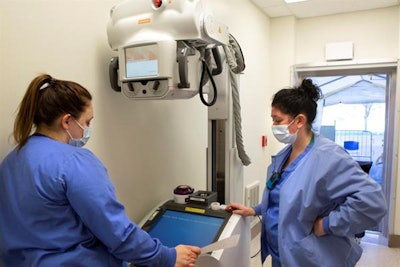 Natalie Conrad, right, and Katarina Kunkel, radiologic technologists with Penn State Health Milton S. Hershey Medical Center, set up the portable x-ray machine. Image courtesy of Penn State Health.
Natalie Conrad, right, and Katarina Kunkel, radiologic technologists with Penn State Health Milton S. Hershey Medical Center, set up the portable x-ray machine. Image courtesy of Penn State Health.Operation of the radiology annex began on April 3, but it soon ran into a snag. The plexiglass was so thick that the technologist couldn't hear instructions given by another RT operating the equipment inside the building. This problem was solved when the hospital's security guards loaned the department their walkie-talkies so patients can be given commands, such as when to hold their breath during studies.
In a statement, Penn State Health noted that x-ray isn't sensitive or specific for COVID-19, and it is not recommended as a diagnostic tool for SARS-CoV-2 infection. At Penn State, the modality is primarily being used to differentiate COVID-19 from other conditions that could mimic the disease, like bacterial community-acquired pneumonia.
"For some patients with mild symptoms and imaging findings that can be seen in COVID-19 pneumonia, the chest radiograph may lead a provider to send that patient for viral testing for COVID-19," said Dr. Timothy Mosher, chair of the department of radiology at Hershey Medical Center, in the statement.




